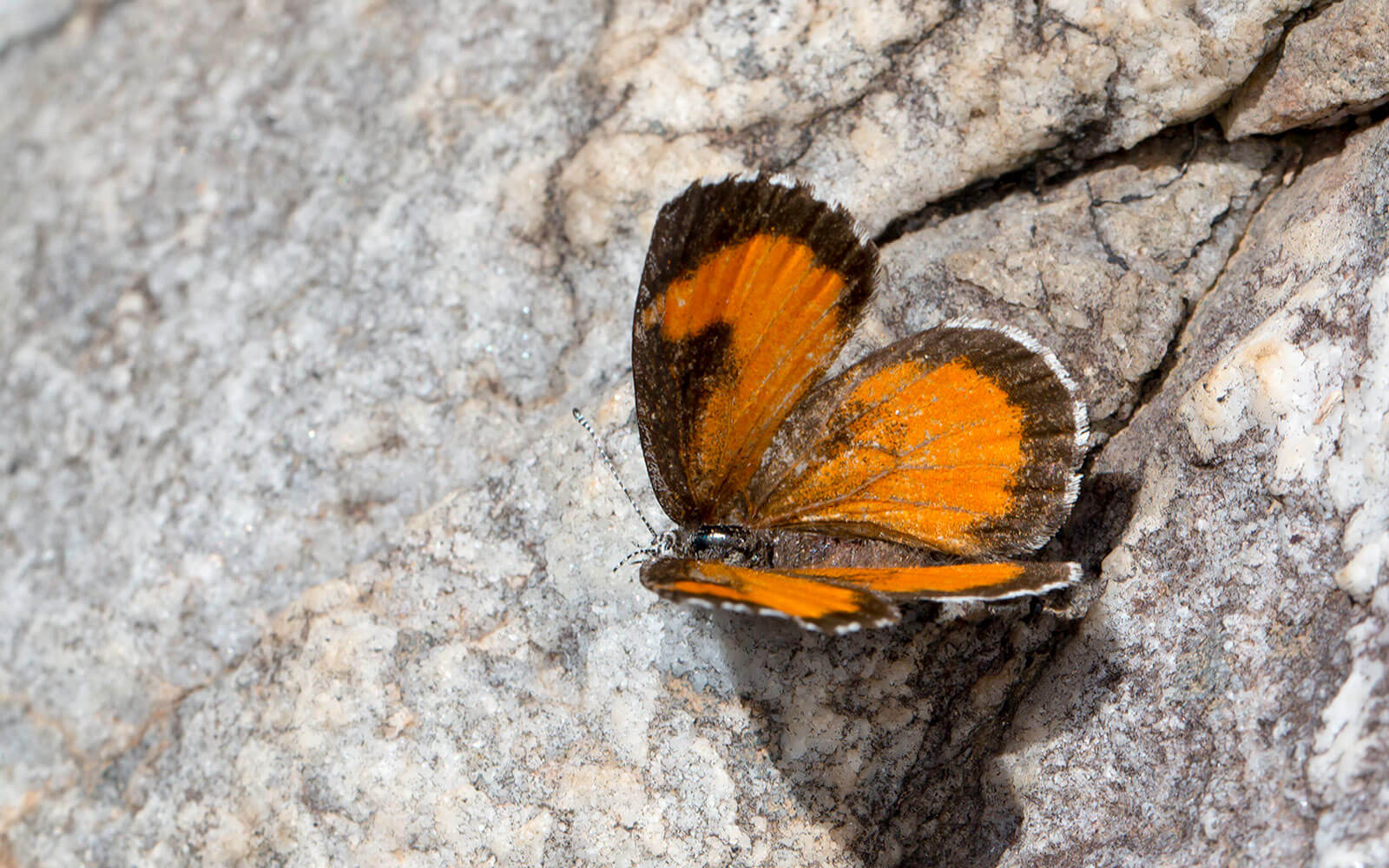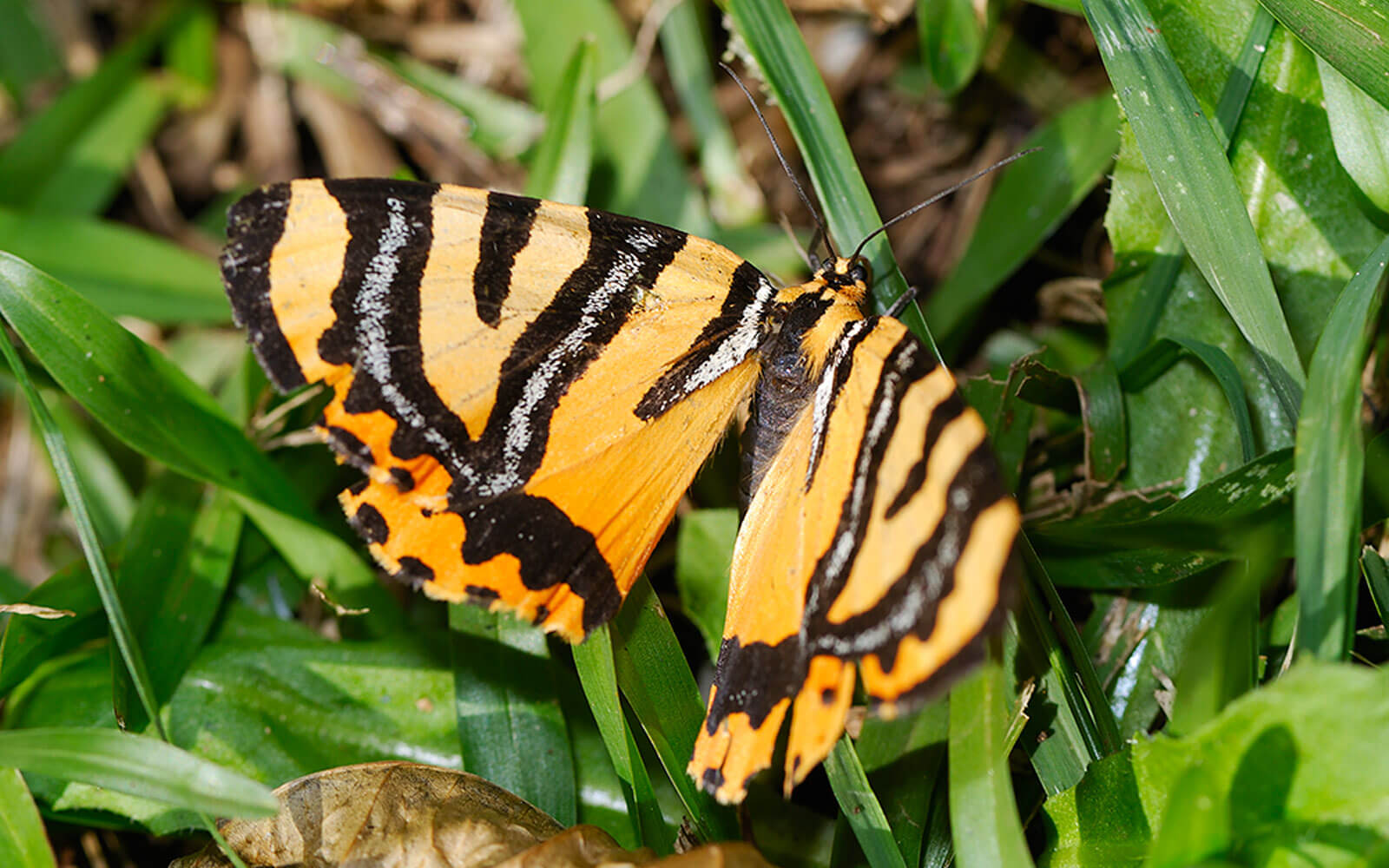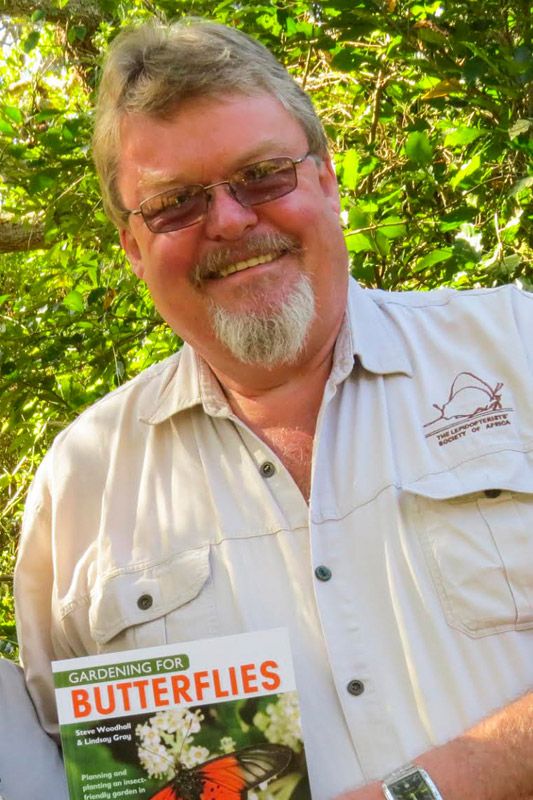Butterflies (and moths) vary a lot in how common and widespread they are. Some, like the Citrus Swallowtail Papilio demodocus demodocus and Blue Pansy Junonia oenone oenone, are found virtually all over the country. Their host plants (Citrus and other Rutaceae for Swallowtails, and Justicia, Asystasia and other Acanthaceae for the Pansy) are common and they have a wide environmental tolerance.

Blue Pansy Junonia oenone oenone male

Papilio demodocus male
Other butterfly and moth species are very specialised and are only found where the conditions are exactly right. We have quite a few of these in the Kloof area – as we will see.
Common Bush Brown Bicyclus safitza safitza
A small to medium sized brown to black butterfly with a bouncing, dancing flight.
Where?
In shady areas of woodland, in the understorey. Although it is called ‘Common’, it is very much a habitat specialist. It is only found in South Africa’s forested areas – and does not stray far from them.
When?
Most of the year, but mostly in spring and midsummer. During the day, on cool and misty days and early in the morning or in the late afternoon.
Why?
Its host plants are shade-loving species of grass, which exclusively grow in forests. Many species of small browns (Satyrinae) are found in Africa’s forests – but in SA we really only have three species (this one, Squinting Bush Brown Bicyclus anynana anynana, and Rainforest Brown, Cassionympha cassius).
These plants (an example is Basket Grass Oplismenus hirtellus) are fortunately easy garden subjects, and in Kloof you might not have to plant them – they often turn up by themselves and prove to be the only grass that can tolerate very deep shade. So the enchanting sight of half a dozen or more Bush Browns flying in a circle low down in the forest is something local gardeners often see.

Bicyclus safitza pupa

Bicyclus safitza 5th instar

Bicyclus safitza male

Bicyclus safitza female
Gaudy Commodore Precis octavia sesamus
A medium sized, brightly coloured butterfly with two distinctive seasonal forms.
Where?
It depends on the time of year. The orange summer form natalensis is found on hilltops and ridges in open country. The blue winter form sesamus is found skulking low down along stream banks, caves and hollows. ‘Hilltopping’ is a common butterfly mate location behaviour. It’s a bit like the childhood game ‘King of the Castle’. The males frequent hilltops and engage in aerial battles to establish dominance. The dominant male then perches at the highest point – and females then approach the hilltop in search of a mate. The dominant male spots the female, chases after her and mates her. The second most dominant male then moves to the top… and on it goes.
When?
The blue form usually appears in late summer and autumn – March to May – and spends the cool months preserving its energy by hiding away in the shade, emerging on warm days to have a nectar meal. In early spring they move to the hilltops to look for mates, by which time they are usually pretty tatty and worn. The orange form appears in October and November, and quickly makes its way to the hilltops where it is very active. It may be found mating with blue ones.
Why?
The Gaudy Commodore is an extreme example of seasonal dimorphism. The dark blue winter form has an almost black underside which camouflages it in the shade, and like many of its subfamily (the Nymphalinae) it overwinters as an adult. Its dark colouring makes it warm up quickly in the sun when the days start to get longer. The red-orange summer form has a lesser need for camouflage – its priority is to find a mate and then lay eggs. Its pale colouration reflects heat and cools the butterfly down. If you look carefully, both forms have some markings in common. The rows of black spots along the outer part of the wings is visible in both, and the winter form has blotches of red corresponding to each black spot.
The Gaudy Commodore’s larvae feed on several species of Spur-flower (Plectranthus sp.). So it is not difficult to attract to your garden.

Precis octavia sesamus final instar larva

Precis octavia (Gaudy Commodore) summer form

Precis octavia (Gaudy Commodore) winter form
Yellowish Amakosa Rocksitter Durbania amakosa flavida
A small, secretive, rare butterfly with an exquisitely camouflaged underside.
Where?
Around certain sandstone boulders in grassland near the top of grassy ridges in the Outer Highway area (and up to Ongoye Forest). Each little colony is isolated from its relatives and it’s unlikely that the butterflies often move from one colony to another. Not all clusters of boulders harbour colonies of Rocksitters. The species has more than one subspecies – they are found all they way from Grahamstown to Long Tom Pass – but subspecies flavida is special to our area – and its IUCN Red List status is Endangered. The good news is that two colonies were discovered inside our local protected area, Krantzkloof Nature Reserve, by Mark Liptrot, just before Christmas. Its future here in Kloof is thus a lot more secure! Its underside is exquisitely camouflaged against the orange and grey colours of the lichen-covered rocks. The upper side female is subspecies penningtoni from Grahamstown.
When?
Mid-November to early January – the larvae take all year to grow to adulthood. The butterflies emerge from the chrysalis in summer, mate, lay eggs and the cycle starts again. Unlike many subtropical butterflies, they are ‘single-brooded’. There is only one generation per year. And because the adults lack functional mouthparts (they don’t have a proboscis to suck nectar like other butterflies and moths do) the adults are short-lived – no more than a week or two.
Why?
These butterflies are totally dependent on the cyanobacteria part of lichen (which is a symbiont with fungi). The biologies of lichens are poorly known, but we generally find these butterflies on rocks that have red or orange ‘crustose’ lichens on them. The ovum and larva shown here are subspecies albescens and natalensis.
This is NOT a garden butterfly. There are a few colonies around Kloof, as well as on Alverston and Inchanga Hill. It’s rare. And if you buy those attractive sandstone rocks sold by unscrupulous people, you may be contributing to its rarity. Several local colonies have been affected by ‘rock rustlers’!

Durbania amakosa albescens egg

Durbania amakosa natalensis larva

Durbania amakosa flavida female

Durbania amakosa flavida male

Durbania amakosa flavida male upper side

Durbania amakosa penningtoni female

Durbania amakosa flavida spot after rocks removed by rock rustlers
Dimorphic Tiger Callioratis abraxas abraxas
This is a medium sized, spectacular Cycad moth which is reasonably common in the Krantzkloof Gorge.
Where?
In and around Krantzkloof’s forests, where the primary host plant Encephalartos villosus (Poor Man’s Cycad) grows. The plant sometimes occurs on forest edges, but the moth only uses plants found in the forest understorey. The moth is also found from Oribi Gorge to the Lebombo Mountains, but people often see it in Kloof, where it is usually taken for a butterfly.
When?
Adults fly from March to May. Females can be seen patrolling the forests and nearby grasslands. Males are found in groups (‘Leks’) flying in groups around the large trees separated from the rest of the forest canopy. Both sexes are fond of flowers, particularly those of the ‘Cabbage Tree’, Cussonia spicata.
Why?
These spectacular moths are part of the subfamily Diptychinae of the family Geometridae (Loopers). The females lay their eggs on the leaves of Encephalartos villosus and other Cycads, which are common in the Kloof area. The larvae eat the leaves, then move off the Cycads onto the leaves of secondary foodplants after the 3rd instar. They have been found on Carissa sp. (Num Num), Apodytes dimidiata (White Pear) and Diospyros whyteana (Bladder-nut). Some larvae do not utilize a secondary foodplant and remain to feed on their primary cycad host until pupation.
Cycads are ‘living fossils’ and it’s likely that so are these moths. Lepidoptera most likely evolved in the Jurassic – 300-350 million years ago. Modern humans have been around for only about 300 000 years…
Kloof is home to several species of Cycad Moth – Dimorphic Tiger is the biggest and most spectacular. Others are Veniliodes setinata (no common name), an undescribed species, and the very common Leopard Magpie, Zerenopsis lepida. Gardeners in the area love to hate the latter because its females lay eggs on cherished garden cycads and the gregarious larvae wreak destruction on the leaves. Out comes the can of Doom or other such toxic substance, and not only the larvae of the Leopard Magpie suffer, but also any other insects downwind of the spray! Dimorphic Tiger females tend to choose Cycads in the deep forests of Krantzkloof, and the larvae are solitary and feed on the older leaves – but people don’t discriminate – ANY caterpillar on their Cycads must DIE!
This is a plea not to unleash chemical warfare on any caterpillar you may find on your Cycads. There is a reasonable chance that (in our area) it belongs to a rarer, valuable species. You would never know. Indiscriminate spraying with insecticide is bad for biodiversity – and that’s another story – you might wipe out a population that’s been there ten thousand times longer than we humans have!
And the Cycad will grow back…

Callioratis abraxas female

Callioratis abraxas female

Callioratis abraxas male

Zerenopsis lepida male

Steve Woodhall is a butterfly enthusiast and photographer who began watching and collecting butterflies at an early age. He was President of the Lepidopterists’ Society of Africa for eight years, and has contributed to and authored several books, including Field Guide to Butterfl ies of South Africa and the popular What’s that Butter fly?